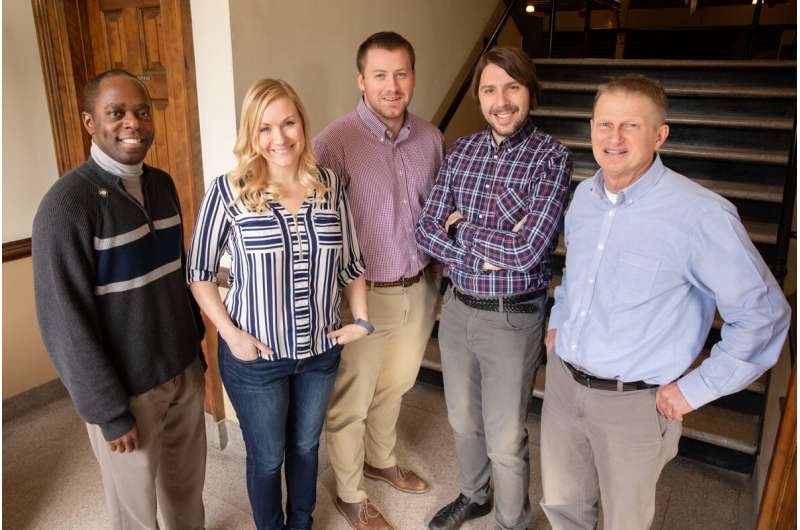Residents who repurposed vacant lots through Chicago's Large Lot Program reported in a new study that the projects made their neighborhoods safer, quieter, friendlier places to live. The study was co-written by U. of I. scholars, from left, postdoctoral researcher Douglas A. Williams; natural resources and environmental sciences professor Carena J. van Riper; graduate student John Strauser; and recreation, sport and tourism professors Alessandro Rigolon and William P. Stewart. Credit: L. Brian Stauffer
Chicago's vacant lot-repurposing program is enhancing not just the curb appeal of blighted properties across the city, but also the culture and safety of the surrounding communities, residents said in a new study.
Chicago's Large Lot Program allows existing property owners to buy up to two vacant residential lots on their blocks for $1 each.
Nearly 200 people who purchased properties during the first wave of sales in spring 2014 participated in the study. Researchers from the University of Illinois conducted the project with Paul H. Gobster, a research landscape architect with the U.S. Department of Agriculture Forest Service Northern Research Station, which funded the research.
Buyers can use their lots for purposes that comply with residential zoning codes, such as maintaining a green side-yard, social or play space, organizing a community garden or constructing garages or some types of extensions of their homes. The new owners are required to pay the property taxes, maintain the lawns and shrubs, and fence any lots that are not side-adjacent to their homes.
Working with city officials, neighborhood associations and the nonprofit organization the Local Initiatives Support Corporation, the researchers surveyed and conducted focus groups with buyers in the East Garfield Park, Englewood and Woodlawn subdivisions about the costs and benefits of the program.
Prior to being sold, the empty lots attracted unwanted activities including drinking and drug use, illegal dumping and nuisance animals, residents said.
The majority (54 percent) of the lots purchased adjoined buyers' existing properties, while 24 percent were less than five lots away. Some of the participants said that owning the properties strengthened their feelings of investment and pride in their community.
Residents who buy lots through the program are required to hold on to them for at least five years. That rule, along with restricting purchases to existing residents, prevents outside investors from entering the market, and protects longtime, low-income residents from being displaced by gentrification, said co-author Alessandro Rigolon, a professor of recreation, sport and tourism.
Visual signs that the lots were being cared for by the new owners changed the character of their communities, discouraging crime and making their neighborhoods quieter, safer, more pleasant places to live.
"Many of the owners developed an emotional attachment to these spaces," said lead author William P. Stewart, a professor of recreation, sport and tourism. "With the simple acts of mowing, building a fence or installing a garden, they cared for these lots in ways that increased the value of the block to people who lived there. They came to know their neighbors better because people would come to talk with them while they were working outside. There was increased social interaction that led to a desirable sense of place and community."
While some owners intended only to meet city codes by keeping the ground cover mowed and the trees and shrubs trimmed, other residents planted vegetables or fruit trees with the intent of sharing the produce with family members or neighbors.
Other owners told the researchers that they planned to create beautiful spaces with flowers, ornamental shrubs and seating or play areas that would encourage visitors to linger and enjoy their surroundings.
"It was inspiring that people had really passionate stories to tell," said co-author Carena J. van Riper, a professor of natural resources and environmental sciences. "They were enthusiastic about fixing up the neighborhood and committed to beautifying their homes."
While empty lots often serve as painful reminders of people, jobs and resources that are no longer there, resident-led neighborhood improvement efforts such as the Large Lot program "allow people within the community to dictate what the future is going to be," said graduate student John Strauser, who co-wrote the study.
Working with neighbors to care for urban gardens enables residents to "actively envision the transformation of bleak circumstances into places of opportunity for a better life," co-author Douglas A. Williams wrote in his doctoral dissertation, which examined the effects that repurposing vacant lots for urban gardens had on residents of one of the neighborhoods in the current study.
Williams' personal ties to some of the residents may have fostered trust in the study that encouraged more community members to participate in the survey, the researchers said. Those personal connections, coupled with the public support of the other project partners, helped the team attain a 71 percent response rate on the survey.
The study was published recently in the journal Landscape and Urban Planning.
More information: William P. Stewart et al, Resident-led beautification of vacant lots that connects place to community, Landscape and Urban Planning (2019). DOI: 10.1016/j.landurbplan.2019.02.011
Provided by University of Illinois at Urbana-Champaign






















